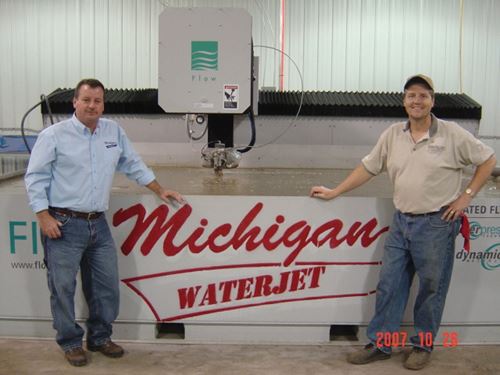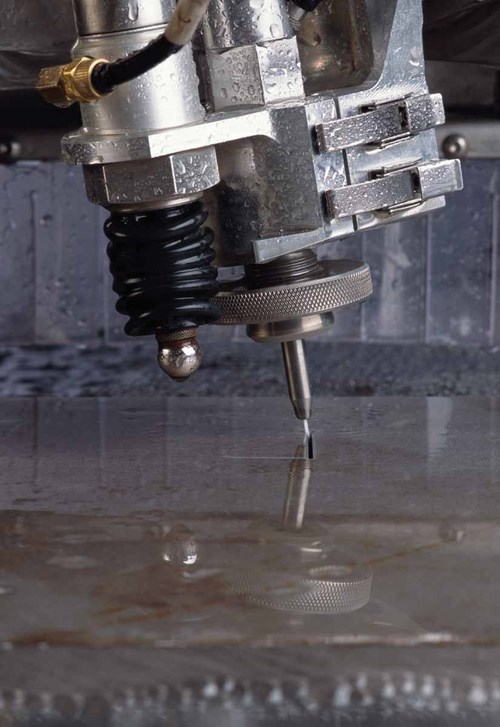Waterjets Increase Pressure On The Competition
Featuring high-pressure pumps and Dynamic Cutting technology, waterjets from Flow International help this shop maintain its competitive edge.
Share








It might be intuitive to think of accuracy and speed as a manufacturing tradeoff—increasing one might compromise the other. According to one Albion, Michigan-based manufacturer, however, that’s not the case with waterjet machines from Flow International (Kent, Washington). These models’ high-pressure streams and ability to offset the natural taper that often occurs with waterjet cutting have enabled the shop to regularly outclass its competition despite having only a few years in business, says co-founder Jack Bates.
Mr. Bates and Landon Clawson launched Michigan Waterjet in 2007 after recognizing an underserved niche for waterjet service in the aerospace and military markets. One of waterjet machining’s primary advantages is that the process produces no heat. In contrast, heat generated by conventional processes can either distort parts entirely or harden the workpiece material to the point where tool life suffers and additional machining work is more difficult, Mr. Bates explains. Waterjet also provides the flexibility to cut materials ranging from heavy steel to aluminum, rubber, glass and ceramics with relative ease in a single step.
However, deciding to specialize in waterjet machining was an easy proposition compared to deciding what specific models would best facilitate timely delivery of high-quality, precision parts. Mr. Clawson, who has a solid background in waterjet cutting technology, had heard buzz in the industry about pumps from Flow International that delivered 87,000 psi of water pressure. After spending a great deal of time comparing this technology to other options, Mr. Clawson and Mr. Bates were sold. "I literally researched 87,000-psi waterjet cutting 24 hours a day, 7 days a week, for months," Mr. Bates says. "In the end, we were impressed, and we implemented this technology into our business without hesitation."
The shop now contains two Flow machines. Complementing the waterjets are two laser cutting machines from Mitsubishi Laser (Wood Dale, Illinois), which are used for jobs in which heat is not a concern. These four machines occupy very little of the available 20,000 square feet of floor space, leaving the shop plenty of room to expand as business grows. Considering how the high-pressure pumps and other waterjet features have impacted the shop’s productivity already, future expansion is not an unlikely
proposition.
According to Flow, the industry standard for waterjet pump pressure is 60,000 psi. Cutting at 87,000 psi raises power density by 75 percent compared to the standard. Increased power density translates to a faster stream that transfers more kinetic energy to the abrasive particles within it. In addition to improving production capacity, the fact that the accelerated stream imparts more cutting power into each abrasive particle reduces costs. That’s because less abrasive is needed to remove the required amount of material on any given job.
Michigan Waterjet didn’t stop there, however. Although its machines shipped with 87,000-psi pumps as a standard feature, the shop has since incorporated one of Flow’s more recent developments: the HyperPressure system, which provides 94,000 psi. HyperPressure is not just a pump, but a complete system incorporating components such as a quick-acting on/off valve, an advanced cutting head, custom plumbing materials and more, all designed to increase cutting power and reduce operating costs.
To avoid unnecessary fatigue on the machine, the shop doesn’t always use the highest pressure setting, Mr. Bates says. For particularly time-sensitive work, however, that capability is invaluable. "Cut quality is always our No. 1 concern, and all waterjets are capable of quality cuts—you can cut with a 55,000-psi machine and get the same results that I can with 94,000 psi. The advantage of high pressure is that it allows us to do the job faster," he explains. "With today’s ‘just in time’ philosophy, that has proven to be really beneficial."
While high-pressure streams enable faster material removal at the point of the cut, the shop also relies on its ability to feed the stream into the workpiece quickly without compromising part quality. This is facilitated by another technology that complements the high-pressure pumps: Flow’s Dynamic Waterjet with Active Tolerance Control. This system compensates for the natural stream lag associated with conventional waterjets to prevent unwanted edge tapers.
Mr. Bates explains that unwanted tapers are a result of the nature of waterjet cutting, in which the "cutting tool" is a pressurized stream of water imbued with abrasive particles. He compares the effect to spraying a garden hose on the ground along a straight line—
the actual point at which the stream hits the ground is always slightly behind the head of the hose. On a waterjet machine, this effect can cause edge tapers that pose problems for part quality, especially when negotiating corners. Naturally, the faster the feed, the more pronounced the taper, so a typical solution is to slow feed rates.
That’s not necessary with dynamic cutting, which uses a motion control system incorporating mathematical cutting models that control a small, articulated wrist attached to the cutting head. This wrist enables the cutting head to tilt in any direction to compensate for the natural stream lag and taper that occurs with waterjet machining.
The FlowMaster control system performs all the mathematical calculations required for these taper offsets behind the scenes. The operator simply enters material type, thickness, desired edge finish and other basic cutting parameters, and the control does the rest.
"The use of Dynamic Waterjet cutting in combination with the 87,000 psi is key in eliminating taper and delivering a finished product to customers in a timely manner," Mr. Bates concludes. "We are often compared by our customers in quoting. In some cases, we are cutting 50 percent faster than those with 50,000- to 60,000-psi machines."
Related Content
Quick-Change Tool Heads Reduce Setup on Swiss-Type Turning Centers
This new quick-change tooling system enables shops to get more production from their Swiss turning centers through reduced tool setup time and matches the performance of a solid tool.
Read MoreHow to Successfully Adopt Five-Axis Machining
While there are many changes to adopt when moving to five-axis, they all compliment the overall goal of better parts through less operations.
Read MoreInside the Premium Machine Shop Making Fasteners
AMPG can’t help but take risks — its management doesn’t know how to run machines. But these risks have enabled it to become a runaway success in its market.
Read More6 Machine Shop Essentials to Stay Competitive
If you want to streamline production and be competitive in the industry, you will need far more than a standard three-axis CNC mill or two-axis CNC lathe and a few measuring tools.
Read MoreRead Next
Building Out a Foundation for Student Machinists
Autodesk and Haas have teamed up to produce an introductory course for students that covers the basics of CAD, CAM and CNC while providing them with a portfolio part.
Read MoreRegistration Now Open for the Precision Machining Technology Show (PMTS) 2025
The precision machining industry’s premier event returns to Cleveland, OH, April 1-3.
Read More5 Rules of Thumb for Buying CNC Machine Tools
Use these tips to carefully plan your machine tool purchases and to avoid regretting your decision later.
Read More
































.jpg;maxWidth=300;quality=90)

















